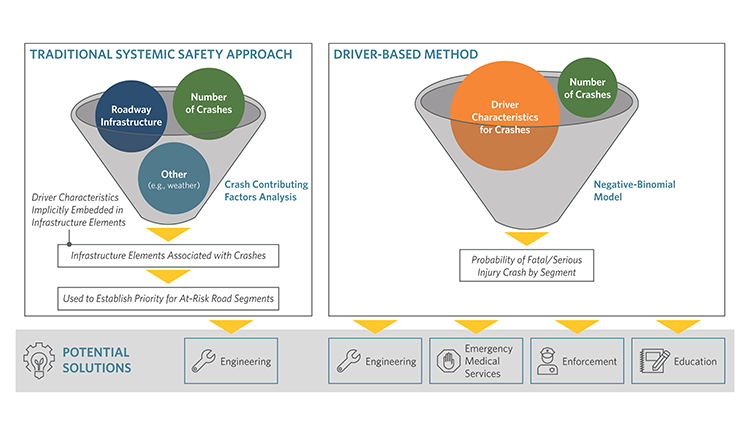MnDOT Risk-Based Traffic Safety Predictive Analysis

MnDOT Risk-Based Traffic Safety Predictive Analysis
An Innovative Approach to Prevent Fatal Crashes and Improve Road Safety
Programs focused on reducing the number of life-changing traffic crashes — such as Minnesota’s Toward Zero Deaths — have plateaued in recent years, leaving the state’s department of transportation seeking alternative ways to reach that goal.
A partnership between the Minnesota Department of Transportation and our team of traffic engineers is testing a new approach to predict where deadly crashes will happen based on driver behavior data instead of infrastructure-based variables. We are analyzing traffic data to identify road segments where high-risk incidents may occur. Those findings are then analyzed using sophisticated statistical models to help MnDOT understand why the crashes are happening and what can be done to prevent them.
Predicting Future Crash Locations
The phased project aims to help MnDOT in determining additional measures that can reduce deadly and serious injury crashes in the state. It provides the necessary information to determine what type of safety strategy is required.
The first phase of the traffic safety study applied the traditional systemic safety analysis approach to evaluating road safety, focused on interstates, U.S. highways and state highways in MnDOT’s District 3 region in central Minnesota. In addition to typical roadway infrastructure, we integrated additional variables, including six years of census data, weather data, crash data, third-party speed and traffic flow data, and Minnesota State Patrol citation data into a unified database with a geographic information system base layer. This data was analyzed using only artificial intelligence and machine learning that could provide unstructured statistical modeling. The goal was to see whether the data would help pinpoint places where fatal crashes were more likely. The analysis identified previously overlooked patterns and relationships, and our model successfully predicted fatal crashes 61% of the time. Importantly, it suggested that some road segments were higher risk than previously considered, revealing new opportunities to prevent or eliminate fatal crashes.
In Phase 2, the proof-of-concept was expanded to include MnDOT’s District 4 region in western Minnesota. With an aim to develop more structured and sophisticated statistical models, we replaced much of the infrastructure data with driver characteristics data, including speed, age, seatbelt use, and if they were driving under the influence or distracted. The refined database was analyzed using two powerful statistical methods, one based on negative binomial regression and another using a Bayesian network model. The goal of both was to develop predictive models for severe and fatal crashes. Both models demonstrated a high degree of accuracy in predicting these incidents, but the negative binomial regression was chosen as the final model due to it being easier to run.
Intervening to Prevent Deadly Crashes
The first two phases of our study showed significant potential in predicting locations of fatal and severe injury crashes based on driver characteristics. The subsequent risk assessment at the identified locations serves as the foundation for exploring targeted interventions to prevent these types of incidents.

Unlike the traditional systemic systems approach, which relies on a lengthy analysis to identify contributing factors and examining infrastructure elements to identify at-risk road segments, our model offers a faster solution that can directly guide interventions beyond infrastructure-based solutions. By incorporating the driver characteristics, the negative binomial model finds the probability of fatal and serious injury crashes along specific road segments, as well as significant predictors of those crashes, including:
- Elderly and younger drivers
- Impaired driving due to drugs or alcohol
- Speed
- Seatbelt use
For instance, the risk assessment identified one high-risk road segment with a high number of crashes involving intoxicated drivers. Further investigation revealed several drinking establishments along the segment, highlighting the need for a combined law enforcement and education strategy to mitigate these crashes.
Based on our findings, we provided MnDOT with several recommended actions to enhance its understanding of road safety needs. One suggestion was incorporating geolocation tags in law enforcement crash and citation reports to better track high-risk areas. Additionally, since seatbelt usage is an important predictor of whether a crash becomes severe or fatal, we advised MnDOT to develop a method to better track seatbelt usage of drivers on the road.
Transforming Industry Safety Through Collaboration
MnDOT is closely reviewing how the findings from the model can be used to identify and implement targeted interventions across all four E's: engineering, emergency response, enforcement and education. By carefully analyzing the results, the aim is to enable a more precise and efficient application of resources and strategies within each area to drive further to zero deaths.








